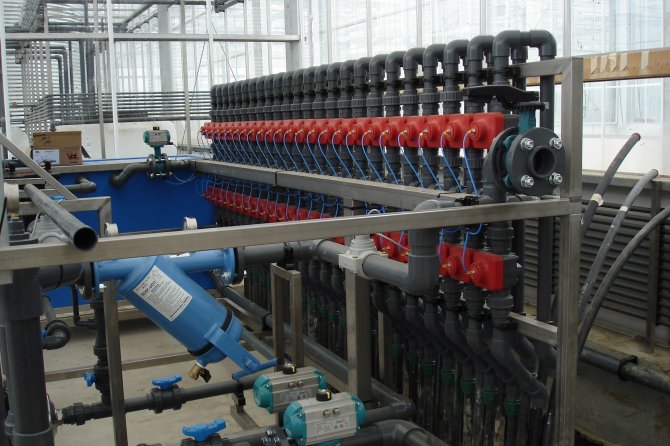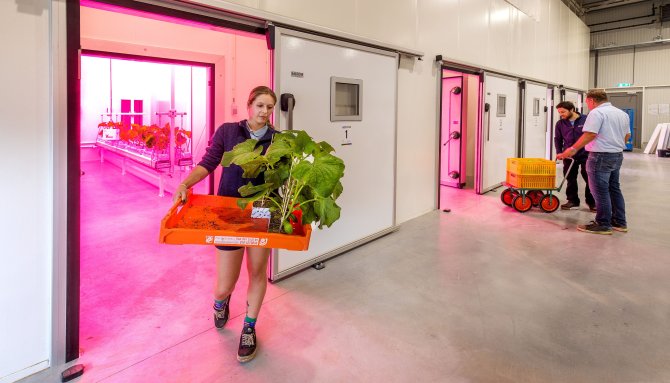Greenhouse facilities Greenhouse Horticulture
The business unit Greenhouse Horticulture has over a hectare in square metres at its disposal for research. The facility is subdivided into over 100 sections.
There are sections that can be used to study the interaction between plant viruses, insects and fungi, and sections where crops are exposed to high levels of fungi or insects. There are also completely conditioned sections, where research can be conducted under various daylight and temperature conditions. Forty sections have been specifically designed and equipped for experiments on the cultivation of vegetables, flowers and potted plants. In addition to the standard equipment, these sections often also have additional specialised equipment available. For example, in some sections, space or substrate can be cooled, a variety of nutrients can be applied, and CO2 and lighting can be scaled to a level of 500 µmol.
The wide range of facilities allows research on many different crops. There are sections specifically equipped for research on:
- Energy-efficient greenhouse and growing concepts and innovative technology to manage the greenhouse climate.
- Strategies and techniques for sustainable crop protection
- Measuring emissions, precisely adding nutrients
- Improving soil resilience and developing novel cultivation systems on water
- New concepts and production systems, closing cycles and combinations of other purposes (to this end, the business unit has, for example, a fish breeding facility)
- New, sustainable vital production systems for the growing of flower bulbs
- Various (dynamic) LED light set-ups
- Low-emission cultivation (ways to reduce CO2, pesticides and artificial fertiliser to zero).

Our greenhouses are driven by a hybrid climate control system that allows externally provided setpoints to be incorporated. This opens the possibility to study autonomous cultivation and new management algorithms for climate control.
To address questions on the best crop selection, climate and cultivation strategy in a vertical farm, the business unit Greenhouse Horticulture has constructed a unique Vertical Farming facility on its Bleiswijk premises. This Vertical Farm facility consists of four growing cells, two multi-layered cells and two cells for the cultivation of tall varieties. The facility offers the unique feature of allowing airtight cultivation in all the cells so that CO2 uptake by crops can be measured in situ. Thus, the climate can be instantaneously adapted to the crop’s requirements.

Moreover, we have, among others, post-harvest facilities, climate cells, cooling cells and an incubator room.
The business unit also houses several laboratories, for research on, for example, flower bulbs, phytopathology/virology, entomology, nematology, soil and crops. There is also a measuring lab, specifically for flavour research.
The business units Greenhouse Horticulture’s testing farm is ISO 9001-2015 credited. We also have several exemptions, which allows us to conduct research on quarantine organisms, admittance research (working with substances that have not yet been admitted), GGO research (containment levels ML I and II, PL I, Ml I, PK I and II, PKM I and II) and opiate-containing crops.
Greenhouses
The greenhouse is constructed according to the Venlo-model, the most popular model in Dutch greenhouse horticulture. The lattice is spaced at 9.60 metres, the bays are 5.00 metres, and the columns are 5.50 metres high. The average gutter hight is 5.70 metres. (Greenhouses used in the Greenhouse as an Energy Source project have different dimensions.)
Almost all of the greenhouses have double-sided venting windows and assimilation lighting. Horizontal and vertical light emissions are reduced through the use of screens. Daylight can be obscured for crops sensitive to day length.
In addition to greenhouses equipped with all of the facilities found in actual businesses, we also have post-harvest facilities (for transport simulations), climate and cooling cells (with a +2°C to +35°C range) and a workshop.
Climate control
The entire greenhouse is equipped with a hybrid climate control system. Setpoints provided externally can be integrated. A computer manages the installation per section. The 40 sections used by the Greenhouse as Energy Source project can be cooled as well as heated. Most sections are equipped with two heat-grids that can be operated individually. Because the windows in the greenhouse complex are fitted with gauze, visits from insects are prevented as much as possible.
Growth management
Each greenhouse section has at least one storage bin for a nutrient solution, which is monitored and managed by a computer. Drain measurements can be conducted in all sections, CO2 can be dosed, and electrical conductivity (EC) lowered. Moreover, each section has a tapping point for irrigation water. All settings are stored in a central database.
Research facilities
The business unit has several laboratories for research on, for example, flower bulbs, phytopathology/virology, entomology, nematology, soil and crops. Moreover, there is a measuring lab for flavour research. In these labs, a variety of organisms are cultivated and assessed. There is also a microscopy chamber and a section where destructive observations on plants can be conducted. These spaces are located in the industrial building and integrated into the greenhouse complex. The Flavour Lab, DNA lab and Entomology lab are located in the office building. Additionally, there are two climate cells for post-harvest research, a shelf-life space, an equipment room (for counting insects or nematodes, for example), drying kilns and freezers.
The sensory lab (Measuring lab) is equipped to develop and test flavour models and 5 tasting units. The Flavour lab has various specific testing set-ups and cooling units to store products. Moreover, processing equipment is available for the preparation of products.